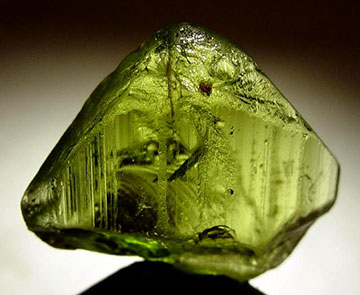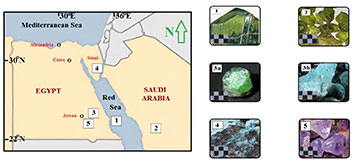Locations of the investigated gem minerals from Egypt and Saudi Arabia, with scaled photos of colored gem minerals on the right. The first row shows peridot, and the second row are emerald and amazonite. The last row depicts emerald and amethyst. For all gem pictures, the field of view is 4 cm. [Image: Khedr et al.] [Enlarge image]
Since prehistoric times, humans have valued and traded precious and semiprecious gemstones. Modern spectroscopic techniques could trace the origins of gems found in ancient archaeological sites.
Researchers based at an Egyptian university applied three different types of spectroscopy to a collection of silicate crystals from the Arabian-Nubian Shield, a geological region of the Middle East (AIP Advances, doi: 10.1063/5.0157623). In the first study of its kind, the team detected elements that give the gemstones their colors and distinguished between stones from inside and outside the region.
Quantifying archaeology
Even as archaeology morphed from an amateur pastime to a professional discipline in the 19th century, it remained a relatively descriptive field of study. In the last few decades, however, archaeologists and their collaborators in the physical sciences have brought new precision methods to the work.
One technique, laser-induced breakdown spectroscopy (LIBS), excels at rapid analysis of chemical composition. In LIBS, an infrared laser heats a tiny region of a sample and turns it into a plasma; the plasma’s emission spectrum reveals the constituent elements.

Peridot crystal found on the Zabargad island off the Red Sea coast of Egypt. This crystal was not part of the study. [Image: R.M. Lavinsky / Wikimedia Commons]
The group led by Amal Abdelfattah Khedr of Cairo University, Egypt, and Jouf University, Saudi Arabia, used a Q-switched Nd:YAG laser operating at 1064 nm to heat the gemstones and collected the spectra through an optical fiber connected to an echelle spectrometer. The near-ultraviolet and short-wavelength visible spectra of amethyst, a variety of quartz (SiO2), showed that traces of iron are responsible for the gem’s beautiful purple color, although the emission lines of silicon were the most prominent feature of its LIBS spectra. LIBS analysis of several other gemstones—including beryl, amazonite and peridot—showed varying quantities of copper and titanium.
Khedr and her colleagues also looked at the gems under a confocal Raman microscope and put them into a Fourier transform infrared (FTIR) spectrometer. The former instrument spectrally distinguished the Egyptian amazonite from other samples of the same mineral dug up in Mexico and Jordan. Meanwhile, FTIR tests showed clear differences between low-gem-quality beryl and its emerald cousins.
Tracing trade routes
“Sometimes, some gemstones were brought by sailors and traders to their homelands. For example, royal crowns in Europe are decorated with peculiar gemstones that originate from either Africa or Asia,” explained author Adel Surour, geologist at Cairo University and Galala University, Egypt, in a press release. “We need to have precise methods to distinguish the source of a gemstone and trace ancient trade routes in order to have correct information about the original place from which it was mined.”
The researchers suggest that other analytical techniques, such as energy-dispersive X-ray spectroscopy, could provide additional data to help distinguish between natural gemstones and synthetic materials that could be fake “artifacts.”

